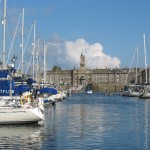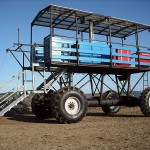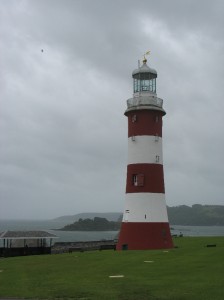Summary: Dartmouth to Plymouth. 37.9 miles in 5 hours and 35 minutes. A slightly frustrating trip – not quite enough wind to sail, so motored all the way. However, a lovely coast to go past.

We left Dartmouth just after 5am after a foul night with heavy rain for most of the night. Though there was a little breeze outside the harbour, there was never quite enough to justify sailing. We had the jib out for an hour or so, but then had to take it back in when it started flopping around all over the place, so we ended up motoring the whole way. We rounded the Mewstone and arrived off Plymouth Breakwater just after 10am. From there we took the shortcut through the Bridge to the west of Drake’s Island and then on to the Mayflower Marina – a Transeurope marina. A very friendly welcome. They gave good directions over the radio and offered to help take our lines as we came in, which we took them up on. They gave us a helpful information pack including free WiFi access – a great start.
The most interesting thing about the journey was the places we went past. After coming out of Dartmouth one of the first places is Slapton Sands. It was here that the disastrous Operation Tiger took place. This was meant to be a D-Day landing rehearsal, but communication and organisational problems led to a series of deaths from friendly fire. General Eisenhower wanted the troops to experience the sights and sounds of live fire and so the Royal Navy were to shell the beach. However, the shelling was delayed because of problems, but this information was not passed properly to the landing boat crews who were on the beach when the firing started. The next day there was a further problem when a convoy of follow-up troops was attacked by German E-Boats in Lyme Bay. It is thought that nearly 950 American servicemen died in this exercise. It was hushed up by the military to try to avoid any damage to morale and was essentially ‘forgotten’ after the war until a local Devon resident, Ken Small, found evidence of the exercise while beachcombing in the early 1970s. He discovered a submerged tank which he persuaded the US Government to sell and this tank now stands as a permanent memorial to the troops who died. The tank is at Torcross.

The trip also took us past Burgh Island in Bigbury Bay, the location of the exclusive 1920s Art Deco hotel – the Burgh Island Hotel. The hotel has been host to an exclusive roll of the rich and famous and is linked to Agatha Christie as And Then There were None was set there. Various other films and programmes have used the island as a setting including a 1994 episode of Lovejoy! Perhaps the best known image of the hotel is the ‘sea tractor’ used to ferry visitors to the island. It stands high to keep visitors above the high water mark.
We have also spotted a couple of well-known boats in Plymouth. The first is the Spirit of Mystery. She is a replica of a Cornish Lugger which made a journey to Australia in 1854/5. The trip apparently came about as a result of a discussion in a pub! She was a Mounts Bay lugger which was built for inshore fishing work, but the seven Cornishmen who owned her decided to seek their fortunes in Australia. They all had shares in the boat and so were proposing to sell the boat to fund their trip, but the captain said he would sail them there. They made such good time to Cape Town that the Royal Mail commissioned them to take the mail on to Australia and they arrived in Melbourne in March 1855. Two of the crew settled in Australia, but five returned home. Mystery remained there as a pilot cutter until she was wrecked in Queensland in 1869. Pete Goss was fascinated by this trip and in 2008 commissioned a replica to recreate the voyage. She was built in 2008 and incorporates wood from the Cutty Sark and HMS Victory as well as some rigging from the SS Great Britain. She left from Newlyn in October 2008 with four crew and arrived in Cape Town in December 2008. She left there again in January 2009, but was knocked down in early March 2009 which resulted in an injury to one of the crew. She had to put in to Portland for him to receive medical attention and the three remaining crew continued to Melbourne, where they arrived in mid March. They were apparently greeted with a pint and a pasty!

The other boat we saw is moored at the Barbican and is Iolaire. She was owned for many years by Don Street – well known pilot book author and sailor. He recently sold her and she appears to be on the market again.

Friday 15th June – Spent the day exploring Plymouth. The boat is rolling around all over the place in Mayflower Marina. As the breeze kicked in, so did the swell and it manages to creep in round the corner of the marina. It made me realise why all the local boats tie their warps to tyres attached to the pontoon cleats by chain! We wandered around the Barbican area and also explored the shopping centre appropriately named Drake’s Circus. The city does like to milk the Drake connection with shopping centres, islands, pubs and shops all named after him. On the Hoe is a statue of him gazing wistfully out to sea with, very appropriately, a bowling green behind him. Whether there is any truth in the story that he finished his game of bowls before attacking the Armada, is highly uncertain as the first written version of it didn’t appear until 37 years after the event. If it did happen then it was probably because he knew the wind and tide were wrong for leaving Plymouth anyway!

Also on the Hoe is Smeaton’s Tower. This lighthouse used to be the lighthouse on the Eddystone Rocks 14 miles out to sea. The first lighthouse on the rocks was a wooden one and was washed away in a violent storm in 1703. The second one burnt down when the lantern started a fire and so in 1756 the Royal Society asked John Smeaton to come up with a lighthouse design that would withstand the weather. He took his inspiration from the shape of an oak tree and the lighthouse was built using 1,493 blocks of stone all dovetail jointed together using marble dowels and oak pins. The design meant that the tower bent in the wind absorbing the forces from the wind and water. The design was used as the model for all lighthouses built subsequently. It lasted 120 years and may well still have been there, if it wasn’t for the fact that the rock the lighthouse was built on rocks that were eroding away. So, a new lighthouse was built and Smeaton’s Tower was moved block by block and rebuilt on Plymouth Hoe as a tribute to John Smeaton and the resilience of his design.

Saturday 16th June – Having exhausted the shops in Plymouth (something that never takes us long), we decided to go for a day out while we waited another day for the weather to clear. We took a ride out to Buckland Abbey. This is a National Trust Property which was, as the name suggests originally a Cistercian Abbey. It was founded in 1278 but fell victim, along with thousands of other abbeys, to Henry VIII’s dissolution of the monasteries. It was bought by Sir Richard Grenville and he and his son (called Roger Grenville – he was the Captain of the Mary Rose when it sank) converted the abbey into a private house and estate. Roger’s son Richard Grenville then sold the house to Drake on his triumphant return from raiding the Spanish in Caribbean and South American waters. Drake himself lived in the house for 15 years and, as he died childless from two marriages, he left the house to his brother. His descendants then lived in the house until 1946 when it was sold to a local landowner, Arthur Rodd. He presented the house to the National Trust in 1948 and it has been open to the public since 1951. It is a combination of museum and house with some rooms furnished appropriately and other as museum galleries run in Association with Plymouth City Museum. An interesting visit and a lovely location on the edge of Dartmoor.
During the day we also met two ‘adventurous’ New Zealanders – Bernie and Graham. Graham is a sailor and knew of Tom and Vicky Jackson and Sunstone. They had been following them during the two-handed round New Zealand race and rooting for them! They are travelling around Europe and the UK for a while and have been chronicling their travels though their Blog – Bernie and Graham’s big adventure.


Hi Andy and Anne,
Thanks for the tips. We will be in Weymouth to morrow after a rather damp and windy day in Torbay.
your adventure is fantastic and I like the titles you give each leg of you circumnavigation.
happy sailing and if you are in NZ look us up… or even in San Francisco we have family who can put you up and take you for a sail on a Very elegant eight metre class yacht called Yucca. (I raced on it and you probably saw photo,s on our blog)
Cheers Graham, and Bernie